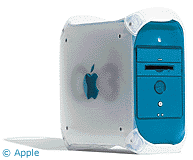Mac Musings
Good-bye XLR8
Daniel Knight - 2002.08.19 -
Applied Engineering, Brainstorm, DayStar, Dove, Extreme Systems, Fusion, Harris, Logica, MacProducts, MacTell, metabox, Mobius, Newer Technology, NewLife, Novy, phase5, Radius, TechWorks, Total Systems, and Vimage.
That's an incomplete list of companies that once made accelerators and CPU upgrades for the Mac - and are no longer with us. As of last Friday, we need to add XLR8 to the list.
Upgrade or Buy New?
The accelerator makers recognized that a lot of Mac users were not only attached to their computers (Macs seem more personal than other brands, instilling greater loyalty to both the Mac OS and particular models), but also that a lot of times we couldn't afford to buy new computers while needing more speed.
From early 12 MHz and 16 MHz upgrades for the Fat Mac and Plus through to G3 upgrades for Power Macs with NuBus slots, L2 cache slots, CPU cards, and ZIF sockets, the processor upgrade vendors gave us a way to keep our low-end Macs while boosting core performance at a modest cost.
Companies came and went. The list of existing vendors is very short:
- MicroMac, hanging in there with processor upgrades for Mac IIs through Quadras.
- Newer Technology, resurrected from the ashes and offering G3 and G4 upgrades exclusively through Other World Computing.
- PowerLogix, with G3 and G4 upgrades for many desktops and G3 PowerBooks.
- Sonnet Technology, which currently offers 1 GHz G4 upgrades alongside 68040 upgrades for 68030-based Macs.
Apple Strikes Back
Apple has never encouraged processor  upgrades,
but until the blue & white G3,
they didn't do anything to prevent them from working, either. And
they didn't do it on the b&w G3 initially - when it was
introduced in January 1999, it could have accepted a G4 upgrade if
any had been available.
upgrades,
but until the blue & white G3,
they didn't do anything to prevent them from working, either. And
they didn't do it on the b&w G3 initially - when it was
introduced in January 1999, it could have accepted a G4 upgrade if
any had been available.
Apple changed that with a mid-May update to the b&w G3's ROM. Users who installed ROM version 1.1 or later lost the ability to simply plug in a G4 processor. It remained for the accelerator vendors to find a way to work around Apple's deliberate attack on their market. (For more info, see Why the G4 Uproar?)
That move set the upgrade vendors back several months, giving Apple the opportunity to sell new computers to those who wanted G4s, but today the b&w G3s can take G4 upgrades running as fast as 550 MHz.
Another Wrench
One more factor gums up the works for the upgrade makers: IBM and Motorola keep redesigning the G3 and G4 processors, improving speed, changing the cache from external to internal, and making packaging changes that make designing upgrades more challenging. Apple, with its vast resources, has no problem embracing these changes, but upgrade vendors have more limited resources and often lag a long ways behind today's Power Mac speeds.
It's been a tough business, as you can see from the names in the first paragraph. Only the strong, the lucky, and the tenacious survive. After all, for the past few years, the fastest CPU upgrade was 500 MHz while the Power Mac zoomed well past that mark. It's only in recent months that the first upgrades finally passed the 500 MHz mark.
What About My Upgrade?
As the owner of several ancient Sonnet 68040 upgrades, a Brainstorm upgraded Mac Plus, and some SuperMacs with Newer Tech and XLR8 upgrades inside, the first thing I want to say is that they work just as well today as they did when I got them. Nothing has changed. They are 100% reliable.
To quote the cover of the Hitchhiker's Guide, "Don't Panic." If you have an XLR8 card in your Power Mac or clone, expect it to continue working as dependably as it has been. (If you're one of the few with a troublesome one, you have my sympathy.) I don't know if there will be any problems with G4 upgrades under Jaguar; I guess we'll have to wait until August 24 to find out.
And the Rest?
XLR8 had a fairly diverse product line. If you've been to Low End Mac lately, you've probably seen the banner ads for InterView, a video-to-USB dongle that has been getting some very good press. XLR8 also sold mice, USB hubs, as well as FireWire PCI and CardBus cards.
Again, I suspect this equipment will continue to work just like it does today for a long time. InterView owners are undoubtedly hoping someone will acquire XLR8's assets and offer the flash updates that XLR8 can no longer provide.
Other than that, I think almost everyone who owns an XLR8 product has nothing to worry about. Hardware tends to fail right away or last for a long, long time.
For those looking for a deal, join those who bought Plymouths or Oldsmobiles during their last year of production. Expect to seem some blowout prices on XLR8 hardware real soon now.
On the other hand, I have a feeling we're not going to see the income from those InterView ads any time soon, if ever, making Low End Mac and other sites on the Mac Web the big losers.